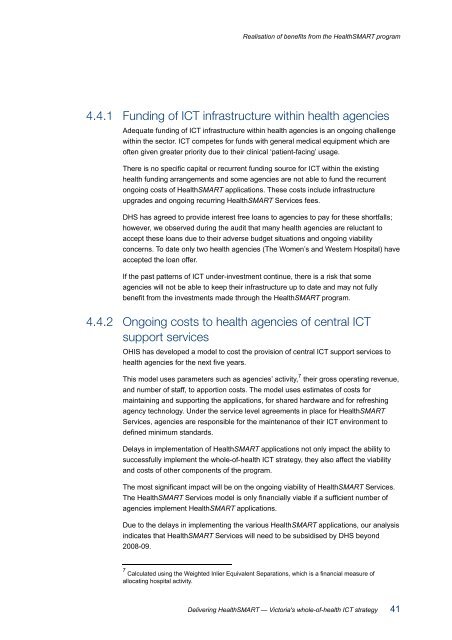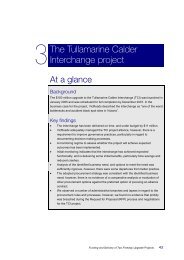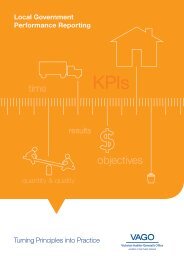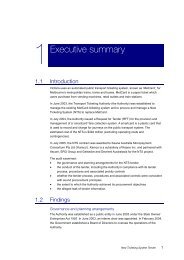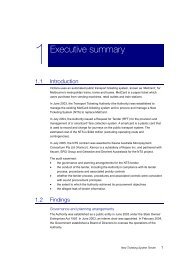Delivering HealthSmart Report - VAGO
Delivering HealthSmart Report - VAGO
Delivering HealthSmart Report - VAGO
Create successful ePaper yourself
Turn your PDF publications into a flip-book with our unique Google optimized e-Paper software.
Realisation of benefits from the HealthSMART program<br />
4.4.1 Funding of ICT infrastructure within health agencies<br />
Adequate funding of ICT infrastructure within health agencies is an ongoing challenge<br />
within the sector. ICT competes for funds with general medical equipment which are<br />
often given greater priority due to their clinical ‘patient-facing’ usage.<br />
There is no specific capital or recurrent funding source for ICT within the existing<br />
health funding arrangements and some agencies are not able to fund the recurrent<br />
ongoing costs of HealthSMART applications. These costs include infrastructure<br />
upgrades and ongoing recurring HealthSMART Services fees.<br />
DHS has agreed to provide interest free loans to agencies to pay for these shortfalls;<br />
however, we observed during the audit that many health agencies are reluctant to<br />
accept these loans due to their adverse budget situations and ongoing viability<br />
concerns. To date only two health agencies (The Women’s and Western Hospital) have<br />
accepted the loan offer.<br />
If the past patterns of ICT under-investment continue, there is a risk that some<br />
agencies will not be able to keep their infrastructure up to date and may not fully<br />
benefit from the investments made through the HealthSMART program.<br />
4.4.2 Ongoing costs to health agencies of central ICT<br />
support services<br />
OHIS has developed a model to cost the provision of central ICT support services to<br />
health agencies for the next five years.<br />
This model uses parameters such as agencies’ activity, 7 their gross operating revenue,<br />
and number of staff, to apportion costs. The model uses estimates of costs for<br />
maintaining and supporting the applications, for shared hardware and for refreshing<br />
agency technology. Under the service level agreements in place for HealthSMART<br />
Services, agencies are responsible for the maintenance of their ICT environment to<br />
defined minimum standards.<br />
Delays in implementation of HealthSMART applications not only impact the ability to<br />
successfully implement the whole-of-health ICT strategy, they also affect the viability<br />
and costs of other components of the program.<br />
The most significant impact will be on the ongoing viability of HealthSMART Services.<br />
The HealthSMART Services model is only financially viable if a sufficient number of<br />
agencies implement HealthSMART applications.<br />
Due to the delays in implementing the various HealthSMART applications, our analysis<br />
indicates that HealthSMART Services will need to be subsidised by DHS beyond<br />
2008-09.<br />
7<br />
Calculated using the Weighted Inlier Equivalent Separations, which is a financial measure of<br />
allocating hospital activity.<br />
<strong>Delivering</strong> HealthSMART — Victoria's whole-of-health ICT strategy 41


